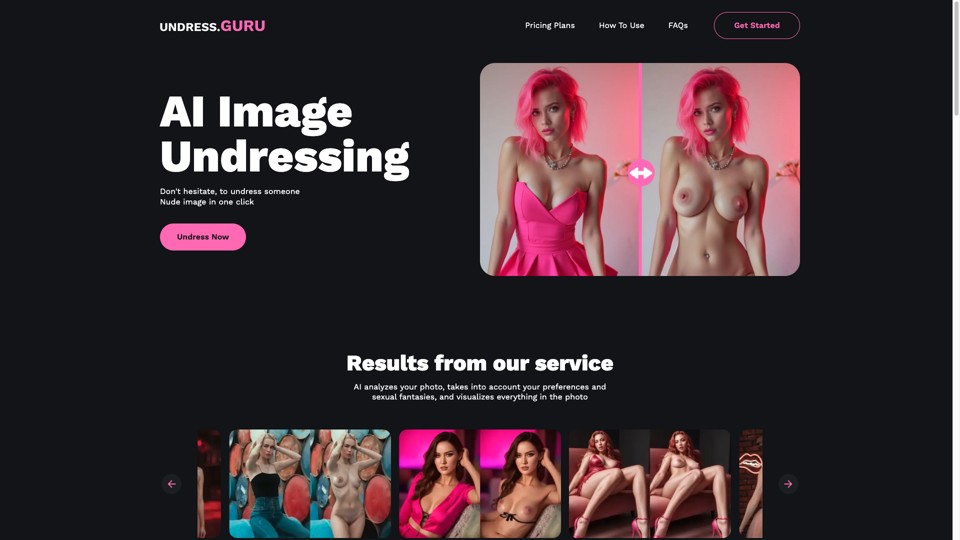Undress.guru is an AI-driven platform that enables users to digitally remove clothing from images, generating simulated nude outputs through advanced machine learning algorithms. The service markets itself as a tool for exploring "sexual fantasies" while emphasizing user privacy, security, and ease of use. This report examines the platform's functionalities, operational framework, pricing model, and associated ethical and legal concerns, contextualizing its place within the broader landscape of AI-powered undressing technologies.
Technical Architecture and Core Functionalities
AI-Driven Image Processing
Undress.guru employs generative adversarial networks (GANs) and stable diffusion models to analyze uploaded images, identify clothing patterns, and reconstruct anatomically plausible nude representations. The system allows users to customize outputs by specifying preferences for body types, breast sizes, and other physical attributes, reflecting advancements in conditional image generation. Unlike basic photo-editing tools, the platform’s neural networks synthesize new pixel data to simulate skin textures, shadows, and anatomical features, resulting in highly realistic outputs.
User Interface and Workflow
The platform follows a three-step process:
- Account Creation: Users must register for a free trial or paid subscription, granting access to a tiered credit system for image processing.
- Customization: Premium subscribers can adjust parameters such as body morphology, clothing removal intensity (e.g., lingerie vs. full nudity), and output resolution.
- Output Generation: Processed images are temporarily displayed on the platform before automatic deletion from servers, though users can download results locally.
This workflow prioritizes accessibility, with the interface designed to minimize technical barriers for non-expert users.
Privacy and Data Security Measures
Ephemeral Data Handling
A key selling point is the platform’s claim to neither store uploaded images nor retain processed outputs on its servers. The FAQ section explicitly states that all content is "completely confidential" and permanently erased shortly after generation, addressing concerns about unauthorized data retention. However, the proprietary nature of this deletion mechanism raises questions about verifiability, as third-party audits of data practices are not disclosed.
Encryption and Anonymity
While the site recommends using VPNs for enhanced privacy, it does not inherently integrate encryption for user uploads beyond standard HTTPS protocols. This contrasts with competitors like Undress.app, which implements end-to-end encryption for all processed images. The absence of robust built-in anonymity tools leaves users reliant on external privacy measures, potentially exposing metadata during file transfers.
Commercial Model and Accessibility
Tiered Subscription Plans
The platform operates on a freemium model:
- Free Tier: Provides three initial credits and one daily credit, limiting output resolution and customization options.
- Starter Plan ($9.99/month): Unlocks 100 credits/month with basic body type adjustments.
- Basic Plan ($19.99/month): Adds manual editing tools and watermark removal.
- Premium Plan ($39.99/month): Grants priority processing, 500 credits/month, and advanced prompts for precise anatomical detailing.
This pricing structure positions Undress.guru as a mid-range option compared to alternatives like xNudes.ai (lower cost) or UndressAI.tools (higher ethical safeguards).
Ethical and Legal Controversies
Consent and Exploitation Risks
Like similar platforms, Undress.guru faces criticism for enabling non-consensual intimate imagery (NCII) creation. The ease of uploading third-party photos-potentially without subjects’ knowledge-violates personal autonomy and facilitates harassment. Studies indicate 78% of deepfake pornography targets women, exacerbating gender-based digital violence. While the site’s terms of service prohibit illegal use, enforcement relies on user reporting rather than proactive detection.
Regulatory Compliance Challenges
Current legal frameworks struggle to address AI-undressing tools due to jurisdictional variances:
- EU: Likely violates GDPR’s Article 9 protections against processing biometric data without explicit consent.
- US: Falls under state-level "deepfake porn" bans (e.g., California’s AB-602) but federal oversight remains limited.
- Asia: Japan’s 2024 AI Ethics Guidelines explicitly prohibit non-consensual body modification tools, setting precedent for regional bans.
The platform’s Polish hosting location complicates legal accountability, as local laws lack specific provisions against synthetic NCII.
Comparative Analysis With Competing Platforms
Technological Differentiation
Undress.guru distinguishes itself through real-time customization sliders and anime-compatible processing, features absent in competitors like UndressCC. However, it lags behind UndressAI.tools in ethical safeguards, as the latter auto-deletes outputs within 48 hours and employs content moderation algorithms.
Market Positioning
With mid-tier pricing and balanced feature sets, the platform targets casual users rather than professional creators. This contrasts with premium services like Undress App AI Pro, which focuses on batch processing for commercial clients.
Mitigation Strategies and User Recommendations
Technical Safeguards
Users should:
- Mask Metadata: Remove EXIF data from uploaded images using tools like ExifPurge to prevent geolocation leaks.
- Use Decoy Accounts: Avoid linking real email addresses or payment methods to minimize identity exposure.
- Local Processing: Run open-source alternatives like DeepNude (community-modified versions) on air-gapped devices to eliminate cloud-based risks.
Platform-Level Reforms
To reduce harm potential:
- Implement blockchain-based consent verification, requiring uploaders to cryptographically prove subject authorization.
- Integrate facial recognition blockers that detect and reject images matching public figures or non-consenting individuals.
- Adopt a "know your customer" (KYC) system for premium tiers, deterring anonymous misuse.
Conclusion
Undress.guru exemplifies the dual-use dilemma inherent in generative AI-offering creative potential while enabling unprecedented privacy violations. Its technical execution demonstrates sophisticated image synthesis capabilities, yet ethical shortcomings persist in accountability mechanisms and misuse prevention. Addressing these issues requires multilateral collaboration between policymakers, AI developers, and digital rights organizations to establish binding ethical standards without stifling innovation. Future iterations could explore ethical AI frameworks like differential privacy-preserving GANs or on-device processing to reconcile user demands with societal safeguards.
